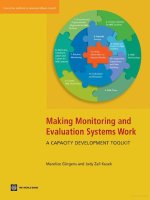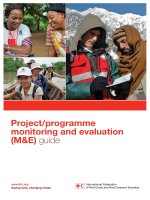program design, monitoring and evaluation
Bạn đang xem bản rút gọn của tài liệu. Xem và tải ngay bản đầy đủ của tài liệu tại đây (2.81 MB, 97 trang )
Program Design,
Program Design,
Monitoring and Evaluation
Monitoring and Evaluation
USAID/Vietnam Informal Training
USAID/Vietnam Informal Training
January, 2004
January, 2004
2
Overview of Training
Overview of Training
Elements of a Program
Elements of a Program
Introduction to Needs Assessment
Introduction to Needs Assessment
Program Design (The Causal Pathway)
Program Design (The Causal Pathway)
Monitoring Program Success
Monitoring Program Success
Evaluation
Evaluation
Proposal Design
Proposal Design
–
Linking a Program Framework to Proposal Design
Linking a Program Framework to Proposal Design
3
Implementation
and Monitoring
Assessment
Program Design
Evaluation
Elements of a Program
4
Implementation
and Monitoring
Assessment
Program Design
Evaluation
Elements of a Program
5
Needs Assessment Basics
Needs Assessment Basics
Why conduct a needs assessment?
Why conduct a needs assessment?
–
To
To
learn
learn
what a group or community sees as the most
what a group or community sees as the most
important needs
important needs
–
To
To
understand the environment
understand the environment
in which you will be
in which you will be
working
working
–
To
To
prioritize
prioritize
what you may be able to do with your
what you may be able to do with your
group or community
group or community
6
Needs Assessment Basics
Needs Assessment Basics
What is a needs assessment survey?
What is a needs assessment survey?
–
Some general characteristics:
Some general characteristics:
Have pre-set list of questions to be answered
Have pre-set list of questions to be answered
Have pre-determined sample size for the number and
Have pre-determined sample size for the number and
types of people to be surveyed
types of people to be surveyed
Should be PARTICPATORY
Should be PARTICPATORY
7
Phases of Needs Assessment
Phases of Needs Assessment
Phase 1:
Phase 1:
Brainstorm
Brainstorm
–
Why am I doing this?
Why am I doing this?
–
What are my goals in conducting the survey?
What are my goals in conducting the survey?
–
Am I ready to do this?
Am I ready to do this?
Brainstorm
8
Phases of Needs Assessment
Phases of Needs Assessment
Phase 2:
Phase 2:
Assess Available Information
Assess Available Information
–
What do I already know about the needs of this target
What do I already know about the needs of this target
group/community?
group/community?
–
What are the existing resources to assist in informing our
What are the existing resources to assist in informing our
assessment?
assessment?
–
Am I ready to do this?
Am I ready to do this?
Brainstorm Assess Available Data
9
Phases of Needs Assessment
Phases of Needs Assessment
Phase 3:
Phase 3:
Develop Questions
Develop Questions
–
What do you want to learn from the target
What do you want to learn from the target
group/community?
group/community?
Brainstorm Assess Available Data Develop Questions
10
Phases of Needs Assessment
Phases of Needs Assessment
Phase 4:
Phase 4:
Identify Target Population
Identify Target Population
–
Who in the community has the information to answer your
Who in the community has the information to answer your
questions?
questions?
–
Consider revising your questions based on the
Consider revising your questions based on the
groups/individuals you have identified
groups/individuals you have identified
Brainstorm Assess Available Data Develop Questions
Identify Target
Population
11
Phases of Needs Assessment
Phases of Needs Assessment
Phase 5:
Phase 5:
Choose Method
Choose Method
–
Consider:
Consider:
Time
Time
Human Resources
Human Resources
Financial Resources
Financial Resources
Size/characteristics of target population
Size/characteristics of target population
Regional/geographic issues
Regional/geographic issues
Brainstorm Assess Available Data Develop Questions
Identify Target
Population
Choose
Method
12
Phases of Needs Assessment
Phases of Needs Assessment
Phase 6:
Phase 6:
Draft the Survey
Draft the Survey
–
Include instructions based on target groups
Include instructions based on target groups
–
Test the survey on a test group comprised of the kinds of
Test the survey on a test group comprised of the kinds of
people you will survey
people you will survey
–
Revise based on the test survey
Revise based on the test survey
Brainstorm Assess Available Data Develop Questions
Identify Target
Population
Choose
Method
Draft
Survey
13
Phases of Needs Assessment
Phases of Needs Assessment
Phase 7:
Phase 7:
Implement
Implement
–
Tabulate results
Tabulate results
–
Interpret results
Interpret results
–
Plan future actions!
Plan future actions!
Brainstorm Assess Available Data Develop Questions
Identify Target
Population
Choose
Method
Draft
Survey
Implement
14
Needs Assessment Tools
Needs Assessment Tools
There are many ways to Engage a community in assessing its
There are many ways to Engage a community in assessing its
needs…
needs…
–
Focus Groups
Focus Groups
–
Community Forums
Community Forums
–
Individual Interviews
Individual Interviews
–
Surveys
Surveys
–
Community Resource Inventories
Community Resource Inventories
15
Needs Assessment Tools
Needs Assessment Tools
Focus Groups
Focus Groups
–
Guided group discussion of 6 to 12 individuals from
Guided group discussion of 6 to 12 individuals from
similar backgrounds with a skilled moderator and,
similar backgrounds with a skilled moderator and,
if possible, a recorder. Moderator guides the group
if possible, a recorder. Moderator guides the group
into increasing levels of focus on key issues.
into increasing levels of focus on key issues.
–
Time:
Time:
1.5 – 2 hours each
1.5 – 2 hours each
–
Expertise:
Expertise:
Moderate
Moderate
–
Cost:
Cost:
Low
Low
16
Needs Assessment Tools
Needs Assessment Tools
Community Forums
Community Forums
–
A series of public meetings to involve the
A series of public meetings to involve the
community in defining and discussing needs. They
community in defining and discussing needs. They
are less formal than focus groups and open to the
are less formal than focus groups and open to the
public.
public.
–
Time:
Time:
2 – 4 hours each
2 – 4 hours each
–
Expertise:
Expertise:
Low
Low
–
Cost:
Cost:
Low
Low
17
Needs Assessment Tools
Needs Assessment Tools
Individual Interviews
Individual Interviews
–
One-on-one interviews with individuals who
One-on-one interviews with individuals who
represent the target population or have extensive
represent the target population or have extensive
knowledge or experience. A skilled interviewer asks
knowledge or experience. A skilled interviewer asks
specific and open-ended questions to obtain
specific and open-ended questions to obtain
information about needs. Respondents can express
information about needs. Respondents can express
their understanding openly and freely.
their understanding openly and freely.
–
Time:
Time:
Not more than 1 hour per meeting
Not more than 1 hour per meeting
–
Expertise:
Expertise:
Moderate
Moderate
–
Cost:
Cost:
Low
Low
18
Needs Assessment Tools
Needs Assessment Tools
Surveys
Surveys
–
Generally three kinds: face-to-face, telephone and
Generally three kinds: face-to-face, telephone and
mailed (emailed).
mailed (emailed).
–
Time:
Time:
Not more than 45 minutes to 1 hour
Not more than 45 minutes to 1 hour
to complete
to complete
–
Expertise:
Expertise:
High
High
–
Cost:
Cost:
High
High
19
Needs Assessment Tools
Needs Assessment Tools
Community Resource Inventories
Community Resource Inventories
–
A means of data collection that usually results from
A means of data collection that usually results from
a survey of service providers, which yields a listing
a survey of service providers, which yields a listing
or summary of information about activities and
or summary of information about activities and
services provided by organizations and agencies in a
services provided by organizations and agencies in a
defined geographic area.
defined geographic area.
–
Time:
Time:
Not more than 1 hour to complete
Not more than 1 hour to complete
–
Expertise:
Expertise:
Moderate
Moderate
–
Cost:
Cost:
Moderate
Moderate
20
Additional Resources for
Additional Resources for
Assessment Tools
Assessment Tools
/> />
/> />
/> />inventory_of_resources/section_2/section_a/a10_somalia_capacity_a
inventory_of_resources/section_2/section_a/a10_somalia_capacity_a
ssessment_tool.pdf
ssessment_tool.pdf
/> />21
Program Design
Program Design
Some quick Definitions:
Some quick Definitions:
–
Cause
Cause
:
:
–
Pathway
Pathway
:
:
–
The
The
Causal Pathway
Causal Pathway
: A framework for designing a
: A framework for designing a
program with clearly defined inputs, activities and
program with clearly defined inputs, activities and
outcomes.
outcomes.
22
Causal Pathway
Causal Pathway
Framework
Framework
Impact
Impact
Change in the health, social,
economic status of the
population of interest
23
Causal Pathway
Causal Pathway
Framework
Framework
Impact
Effect
Effect
Change in the knowledge,
attitudes, skills, behavior
of the population of interest
24
Causal Pathway
Causal Pathway
Framework
Framework
Impact
Effect
Outputs
Outputs
Products and services that
must be in place for the
effects and impact to occur
25
Causal Pathway
Causal Pathway
Framework
Framework
Impact
Effect
OutputsActivities
Activities
Either technical activity or
support required to produce
the outputs






![wiley finance, investment manager analysis - a comprehensive guide to portfolio selection, monitoring and optimization [2004 isbn0471478865]](https://media.store123doc.com/images/document/14/y/xf/medium_QyYI7IBVAK.jpg)


